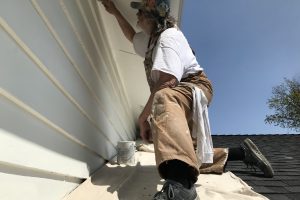07 Jan What is Making the Paint Peel on the Interior of My Commercial Property?
 If the interior of your commercial property looks like a head of hair after a botched perm, your bottom line may begin to suffer as tenants start moving out. Peeling interior paint doesn’t just lower the attractiveness of your property, it can also cause health issues for the occupants. Breathing in paint dust can irritate the respiratory system as well as cause eye problems. Furthermore, if the cause of the peeling paint is water damage, you can expect mould growth in the building and mould-associated conditions as a result. Let’s look at a few probable causes of why the interior walls of your property might be peeling:
If the interior of your commercial property looks like a head of hair after a botched perm, your bottom line may begin to suffer as tenants start moving out. Peeling interior paint doesn’t just lower the attractiveness of your property, it can also cause health issues for the occupants. Breathing in paint dust can irritate the respiratory system as well as cause eye problems. Furthermore, if the cause of the peeling paint is water damage, you can expect mould growth in the building and mould-associated conditions as a result. Let’s look at a few probable causes of why the interior walls of your property might be peeling:
Layers upon layers of paint
When a tenant moves out, landlords prepare the unit for the next tenant and part of this includes repainting the walls. Commercial properties, for this reason, undergo a lot of repainting. Over the years, too many coats of paints become too heavy and this causes the adhesion bonds to weaken. Eventually, paint becomes under-bound, powdery, and begins to fall off. Because you can’t expect a topcoat to adhere to such a surface, the solution would be to scrape off the old paint before applying a new coat. To avoid lead poisoning, you may want to leave this job to commercial painters who will first test the old paint for toxins.
Painters Sydney advise: “Bearing in mind that no paint can properly cover dirty and uneven surfaces, you need to first prepare the walls. If the previous tenant had kids, the walls most likely have some marks and stains. Wipe the walls with a wet cloth to clear lighter stains. For the more stubborn stains, you can use a scrub brush. To fill any cracks and holes, use a putty knife and wood filler. Then to remove loose, flaking paint, use a scraper then smooth the surface with sandpaper. Newly plastered walls may need considerable scraping and sanding to smooth the surface. Basically, the walls should be clean and smooth before you can embark upon painting.”
Water damage
Water is the cause of most peeling issues. A leaky roof, cracked caulking around the window and door frames, cracks, and open joints in siding are all causes of water damage in a building. As water seeps in, it eventually works its way through the walls and pushes the paint off in the process. Excess humidity in the house can also wreak havoc and cause the paint to peel. Peeling paint as a result of water damage calls for a thorough inspection of the building with an aim to deal with the root cause. Otherwise the problem will keep recurring even after you give the walls a new coat of paint.
Paint incompatibility
Paint incompatibility leads to loss of adhesion which causes peeling. If the wall had received an oil-based painting previously, applying a coat of latex-based paint the next time will cause peeling. Interestingly enough, as long as the surface is clean and firm, you can apply an oil-based paint over latex. Before buying paint for your commercial property, you should consult an experienced painter first.
Low-quality paints
The walls of your commercial property may gleam for a while but after some time, the paint will be like paper dollars floating off with each breeze. Because low-quality paints do not dry properly, after a short period of time, they begin to peel off. The same goes for primers. Poor quality primer may hold for a while but as layers begin to build up, the bond weakens and the primer begins to peel off, taking all subsequent coats with it. Cheap, low-quality paints become expensive when you realize you need to paint your walls all over again. High-quality paints, on the other hand, have a lot of resin (the ingredient that makes paints stick) and fewer solvents.
If the interior walls of your commercial property are peeling, don’t fret. At Pinnacle Painting, we customize our Winnipeg commercial painting services for homeowners as well as business owners. Let us restore the glory of your commercial property for you.
